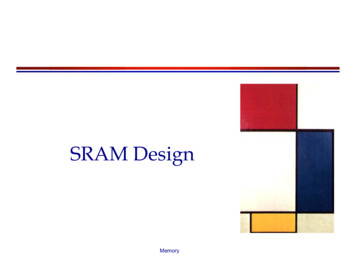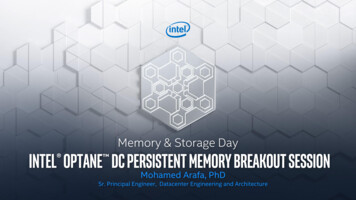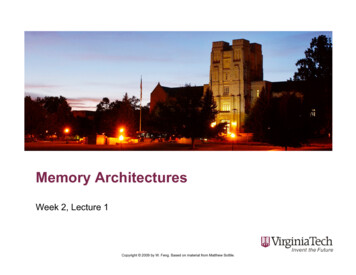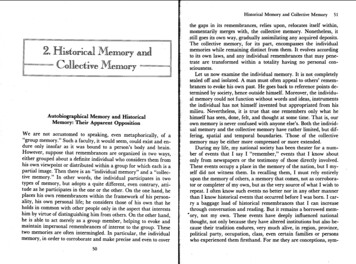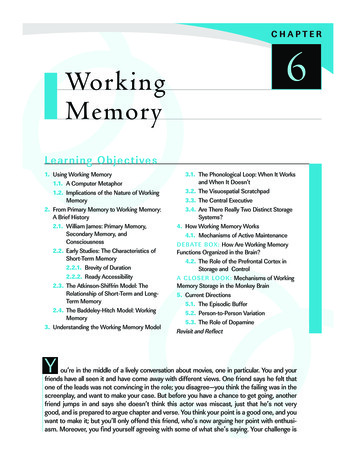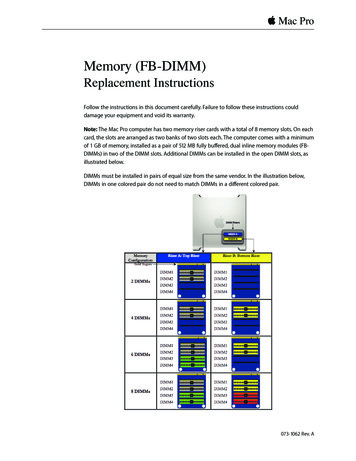
Transcription
College of Information Technology / Department of Information NetworksLEC. 4 . .Computer Science Fundamentals/ First Class / First SemesterCOMPUTER MEMORYI. INTRODUCTIONThe computer’s memory stores data, instructions required during the processing ofdata, and output results. Storage may be required for a limited period of time,instantly, or, for an extended period of time. Different types of memories, each havingits own unique features, are available for use in a computer. The cache memory,registers, and RAM are fast memories and store the data and instructions temporarilyduring the processing of data and instructions. The secondary memory like magneticdisks and optical disks has large storage capacities and store the data and instructionspermanently, but are slow memory devices.The memories are organized in the computer in a manner to achieve high levels ofperformance at the minimum cost. In this lecture, we discuss different types ofmemories, their characteristics and their use in the computer.II. MEMORY REPRESENTATIONThe computer memory stores different kinds of data like input data, output data,intermediate results, etc., and the instructions. Binary digit or bit is the basic unit ofmemory. A bit is a single binary digit, i.e., 0 or 1. A bit is the smallest unit ofrepresentation of data in a computer. However, the data is handled by the computer asa combination of bits. A group of 8 bits form a byte.One byte is the smallest unit of data that is handled by the computer.One byte (8 bit) can store 28 256 different combinations of bits, and thus can be usedto represent 256 different symbols. In a byte, the different combinations of bits fall inthe range 00000000 to 11111111. A group of bytes can be further combined to form aword. A word can be a group of 2, 4 or 8 bytes.1 bit 0 or 11 Byte (B) 8 bits1 Kilobyte (KB) 210 1024 bytes1 Megabyte (MB) 220 1024KB1 Gigabyte (GB) 230 1024 MB 1024 *1024 KB1 Terabyte (TB) 240 1024 GB 1024 * 1024 *1024 KBLecturer: Ali Kadhim AL-Bermani
LEC. 4. . . . . . . . . . . . . . . . . . . . . . . . . . . . . . . . . . . . . . . . . . Computer Science FundamentalsIII.CHARACTERISTICS OF MEMORIES Volatilityo Volatile{RAM}o Non-volatile {ROM, Flash memory} Mutabilityo Read/Write {RAM, HDD, SSD, RAM, Cache, Registers }o Read Only {Optical ROM (CD/DVD ), Semiconductor ROM} Accessibilityo Random Access {RAM, Cache}o Direct Access{HDD, Optical Disks}o Sequential Access {Magnetic Tapes}IV. MEMORY HIERARCHYThe memory is characterized on the basis of two key factors: capacity and access time. Capacity is the amount of information (in bits) that a memory can store. Access time is the time interval between the read/ write request and theavailability of data. The lesser the access time, the faster is the speed of memory.Ideally, we want the memory with fastest speed and largest capacity. However, the costof fast memory is very high. The computer uses a hierarchy of memory that isorganized in a manner to enable the fastest speed and largest capacity of memory.The hierarchy of the different memory types is shown in Figure 4.2.Figure 4.2 Memory hierarchyThe Internal Memory and External Memory are the two broad categories of memoryused in the computer. The Internal Memory consists of the CPU registers, cachememory and primary memory. The internal memory is used by the CPU to perform thecomputing tasks. The External Memory is also called the secondary memory. Thesecondary memory is used to store the large amount of data and the software.2Lecturer: Ali Kadhim AL-Bermani
LEC. 4. . . . . . . . . . . . . . . . . . . . . . . . . . . . . . . . . . . . . . . . . . Computer Science FundamentalsIn general, referring to the computer memory usually means the internal memory. Internal MemoryThe key features of internal memory are:1. Limited storage capacity.2. Temporary storage.3. Fast access.4. High cost.Registers, cache memory, and primary memory constitute the internal memory. Theprimary memory is further of two kinds: RAM and ROM. Registers are the fastest andthe most expensive among all the memory types. The registers are located inside theCPU, and are directly accessible by the CPU. The speed of registers is between 1-2 ns(nanosecond). The sum of the size of registers is about 200B. Cache memory is next inthe hierarchy and is placed between the CPU and the main memory. The speed of cacheis between 2-10 ns. The cache size varies between 32 KB to 4MB. Any program or datathat has to be executed must be brought into RAM from the secondary memory.Primary memory is relatively slower than the cache memory. The speed of RAM isaround 60ns. The RAM size varies from 512KB to 64GB. Secondary MemoryThe key features of secondary memory storage devices are:1. Very high storage capacity.2. Permanent storage (non-volatile), unless erased by user.3. Relatively slower access.4. Stores data and instructions that are not currently being used by CPU but may berequired later for processing.5. Cheapest among all memory.To get the fastest speed of memory with largest capacity and least cost, the fast memoryis located close to the processor. The secondary memory, which is not as fast, is used tostore information permanently, and is placed farthest from the processor.With respect to CPU, the memory is organized as follows: Registers are placed inside the CPU (small capacity, high cost, very high speed) Cache memory is placed next in the hierarchy (inside and outside the CPU) Primary memory is placed next in the hierarchy Secondary memory is the farthest from CPU (large capacity, low cost, low speed)The speed of memories is dependent on the kind of technology used for the memory.The registers, cache memory and primary memory are semiconductor memories. Theydo not have any moving parts and are fast memories. The secondary memory ismagnetic or optical memory has moving parts and has slow speed.3Lecturer: Ali Kadhim AL-Bermani
LEC. 4. . . . . . . . . . . . . . . . . . . . . . . . . . . . . . . . . . . . . . . . . . Computer Science FundamentalsV. CPU REGISTERSRegisters are very high-speed storage areas located inside the CPU. After CPU gets thedata and instructions from the cache or RAM, the data and instructions are moved to theregisters for processing. Registers are manipulated directly by the control unit of CPUduring instruction execution. That is why registers are often referred to as the CPU’sworking memory. Since CPU uses registers for the processing of data, the number ofregisters in a CPU and the size of each register affect the power and speed of a CPU.The more the number of registers (ten to hundreds) and bigger the size of each register(8 bits to 64 bits), the better it is.VI. CACHE MEMORYCache memory is placed in between the CPU and the RAM. Cache memory is a fastmemory, faster than the RAM. When the CPU needs an instruction or data duringprocessing, it first looks in the cache. If the information is present in the cache, it iscalled a cache hit, and the data or instruction is retrieved from the cache. If theinformation is not present in cache, then it is called a cache miss and the informationis then retrieved from RAM.Type of Cache memoryCache memory improves the speed of the CPU, but it is expensive. Type of CacheMemory is divided into different levels that are L1, L2, L3:Level 1 (L1) cache or Primary CacheL1 is the primary type cache memory. The Size of the L1 cache very smallcomparison to others that is between 2KB to 64KB, it depends on computerprocessor. It is an embedded register in the computer microprocessor (CPU).TheInstructions that are required by the CPU that are firstly searched in L1 Cache.Example of registers are accumulator, address register, Program counter etc.Level 2 (L2) cache or Secondary CacheL2 is secondary type cache memory. The Size of the L2 cache is more capaciousthan L1 that is between 256KB to 512KB. L2 cache is located on computermicroprocessor. After searching the Instructions in L1 Cache, if not found then itsearched into L2 cache by computer microprocessor. The high-speed system businterconnecting the cache to the microprocessor.Level 3 (L3) cache or Main MemoryThe L3 cache is larger in size but also slower in speed than L1 and L2, its size isbetween 1MB to 8MB. In Multicore processors, each core may have separate L1and L2, but all core share a common L3 cache. L3 cache double speed than theRAM.4Lecturer: Ali Kadhim AL-Bermani
LEC. 4. . . . . . . . . . . . . . . . . . . . . . . . . . . . . . . . . . . . . . . . . . Computer Science FundamentalsThe advantages and disadvantages of cache memory are as follows:AdvantagesThe advantages of cache memory are as follows: Cache memory is faster than main memory. It consumes less access time as compared to main memory. It stores the program that can be executed within a short period of time. It stores data for temporary use.DisadvantagesThe disadvantages of cache memory are as follows: Cache memory has limited capacity. It is very expensive.VII. PRIMARY MEMORY (Main Memory)Primary memory is the main memory of computer. It is a chip mounted on themotherboard of computer. Primary memory is categorized into two main types:Random access memory (ram) and read only memory (rom). RAM is used for thetemporary storage of input data, output data and intermediate results. The input dataentered into the computer using the input device, is stored in RAM for processing.After processing, the output data is stored in RAM before being sent to the outputdevice. Any intermediate results generated during the processing of program are alsostored in RAM. Unlike RAM, the data once stored in ROM either cannot be changedor can only be changed using some special operations. Therefore, ROM is used tostore the data that does not require a change.Types of Primary Memory1. RAM (Random Access Memory)The Word “RAM” stands for “random access memory” or may also refer to shortterm memory. It’s called “random” because you can read store data randomly at anytime and from any physical location. It is a temporal storage memory. RAM isvolatile that only retains all the data as long as the computer powered. It is thefastest type of memory. RAM stores the currently processed data from the CPU andsends them to the graphics unit.5Lecturer: Ali Kadhim AL-Bermani
LEC. 4. . . . . . . . . . . . . . . . . . . . . . . . . . . . . . . . . . . . . . . . . . Computer Science FundamentalsThere are generally two broad subcategories of RAM: Static RAM (SRAM): Static RAM is the form of RAM and made with flip-flopsand used for primary storage are volatile. It retains data in latch as long as thecomputer powered. SRAM is more expensive and consumes more power thanDRAM. It used as Cache Memory in a computer system. As technically, SRAMuses more transistors as compared to DRAM. It is faster compared to DRAM dueto the latching arrangement, and they use 6 transistors per data bit as compared toDRAM, which uses one transistor per bit. Dynamic Random Access Memory (DRAM): It is another form of RAM used asMain Memory, its retains information in Capacitors for a short period (a fewmilliseconds) even though the computer powered. The Data is RefreshedPeriodically to maintain in it. The DRAM is cheaper, but it can store much moreinformation. Moreover, it is also slower and consumes less power than SRAM.2. ROM (Read Only Memory)ROM is the long-term internal memory. ROM is “Non-Volatile Memory” that retainsdata without the flow of electricity. ROM is an essential chip with permanentlywritten data or programs. It is similar to the RAM that is accessed by the CPU. ROMcomes with pre-written by the computer manufacturer to hold the instructions forbooting-up the computer.There is generally three broad type of ROM: PROM (Programmable Read Only Memory): PROM stands for programmableROM. It can be programmed only be done once and read many. Unlike RAM,PROMs retain their contents without the flow of electricity. PROM is alsononvolatile memory. The significant difference between a ROM and a PROM isthat a ROM comes with pre-written by the computer manufacturer whereasPROM manufactured as blank memory. PROM can be programmed by PROMburner and by blowing internal fuses permanently. EPROM (Erasable Programmable Read Only Memory): EPROM ispronounced ee-prom. This memory type retains its contents until it exposed tointense ultraviolet light that clears its contents, making it possible to reprogramthe memory. EEPROM (Electrically Erasable Programmable Read Only Memory):EEPROM can be burned (programmed) and erased by first electrical waves in amillisecond. A single byte of a data or the entire contents of device can be erased.To write or erase this memory type, you need a device called a PROM burner.6Lecturer: Ali Kadhim AL-Bermani
In general, referring to the computer memory usually means the internal memory. Internal Memory The key features of internal memory are: 1. Limited storage capacity. 2. Temporary storage. 3. Fast access. 4. High cost. Registers, cache memory, and primary memory constitute the internal memory. The primary memory is further of two kinds: RAM and ROM.


